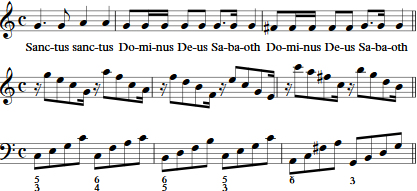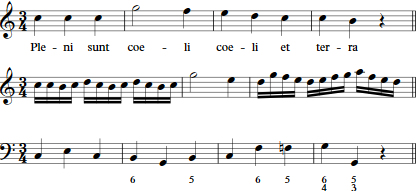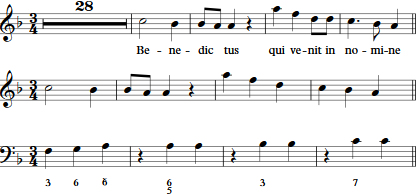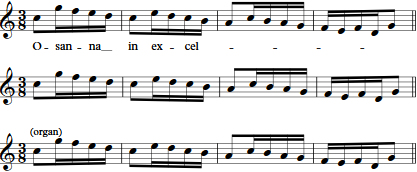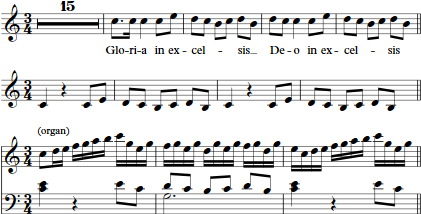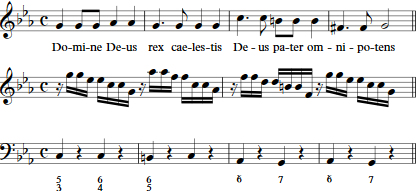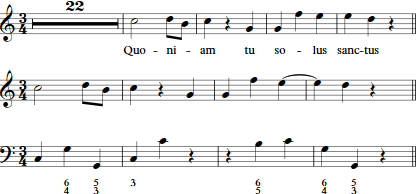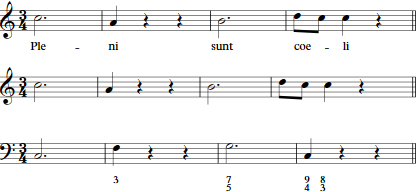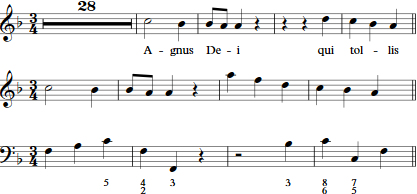Johann Baptist Wanhal
Missa in C Nokki 11 [Weinmann XIX:C2]
Wanhal ?
Nokki 11
Weinmann XIX:C2
Hoboken XXII:C2
Associated name: Joseph Alois Holzmann
Arranger: Vincent Novello
Authenticity: Probably authentic
Whilst this work has been attributed to a few different
names, Wanhal's is the only one to stand out as likely. Not only is the
sheer amount of copies attributed to him suggestive of his authorship,
but the setting of 'Domine Deus, Agnus Dei' as a separate movement and
the final 'Amen' in the Gloria as a movement by itself are typical of
Wanhal's largest settings. The work fits firmly within the stylistic
boundaries of his other 'Domine Deus' masses, even if this setting is
somewhat unconventional by only having one fugal movement.
The occasional attributions to Joseph Haydn are obviously
incorrect. MacIntyre1982 (p. 45) claims that a copy of this piece can
be found in the Lambach catalogue under the name 'Monsching'. Whilst the
bass incipit differs significantly from the mass, however, even if it
fits the melody. (Obermayr1768, p. 28) The manuscript is lost (ibid, p.
318), and there seems to be little reason to believe it contained the
mass in question.
Variants
This work exists in several shortened variants, none of
whom are likely to have been sanctioned by Wanhal. Nokki 11b is the
longest of these:
* Only the first movement of the three-movement Kyrie is used; the middle section of the movement is retexted 'Christe eleison';
* The Gloria is set to the music from the Domine Deus of Nokki 09;
* The Laudamus is of unknown origin;
* The Domine Deus (which in this version also sets the three 'Agnus Dei' calls) is a retexting of the Domine Deus Agnus Dei;
* The Quoniam is rescored for soprano solo rather than tenor solo;
* The Et resurrexit is of unknown origin, but is possibly a reworking, as both versions use the same opening motive;
* The Pleni sunt coeli, Benedictus and Agnus Dei are of unknown origin;
* The Dona nobis is a reworking of the Cum Sancto Spiritu rather than a separate movement.
This is almost certainly a local variant. This is obvious
from the very unusual style of the mass, but in particular the fact
that the 'gratias agimus tibi' line is omitted from the Gloria. Even
though it uses a movement from another mass by Wanhal there is little
reason to suspect the composer's involvement, as this movement is
stylistically very different from his authentic settings of the Gloria.
Vincent Novello published an abbreviated version of the
mass as 'Mass no. 12 by Haydn' in the 1850s (Nokki 11c). This setting
reduces the orchestra to an organ accompaniment, and the number of
movements is greatly reduced through retexting:
* 'Christe eleison' is set in the middle section of the
opening Kyrie. Whilst this procedure is the same as in the example
discussed above, the way the text is set is quite different, and this
seems to speak against a direct relationship between the two;
* The entire Gloria text is set to the first movement of the original;
* The Credo is greatly abbreviated, and parts of the text is omitted;
* The Et incarnatus is of unknown origin;
* The Et resurrexit is greatly abbreviated, and the end re-texted to accommodate the Cum Sancte Spiritu text;
*
The Benedictus and following Osanna are of unknown origin. The former
was may have been replaced because it was the only soloist movement in
the work that could not be easily done away with:
* The Agnus Dei has significant rewriting of the vocal parts in it, but is not abbreviated;
* The Dona nobis is a re-texting of the Kyrie.
These changes have yet to be found in any full
manuscript, and may well represent an adaptation from other works. If
so, these have yet to be identified.
Nokki 11d is easily the strangest variant of any mass by
Wanhal. This reduction for SA choir and organ is attributed to Joseph
Alois Holzmann. The similarity to any other edition ends after the first
three phrases of the Kyrie (after which no music known from other
sources is used), but the degree to which even the alto part is
maintained up to this leaves little doubt that this must have originated
as an adaptation of Wanhal's idea. It is included here primarily for
completion
A Wanhal riddle: a copy in A-Wgm?
Weinmann1987 indicated that a copy of this work existed
in the Gesellshaft der Musikfreunde in Vienna. This work could not be
found in their present card catalogue, and the lack of a shelf mark
suggests that it has never existed.
| 1779 |
Copy in Rahjrad catalogued (original manuscript not seen) |
| 1784 |
Copy in Osek dated |
| 16 Sept. 1798 |
Holzmann version (Nokki 10d) manuscript dated |
| 1855 |
Published in London and New York by Vincent Novello under Joseph Haydn's name |
Original version
Extent: 1724 bars
 Music
Music
Kyrie
 Sections
Sections
-
1. Kyrie
Tempo: Andante
Metre:
3
4
Key: C major
Extent: 131 bars
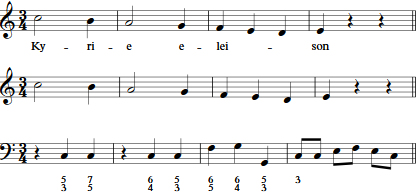
-
2. Christe
Tempo: Andante
Metre:
2
4
Key: F major
Extent: 102 bars
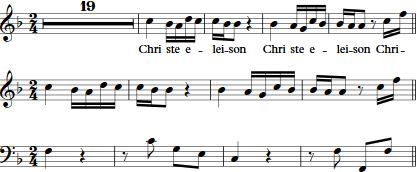
-
3. Kyrie II
Tempo: Allegro
Metre:
𝄵
Key: C major
Extent: 151 bars
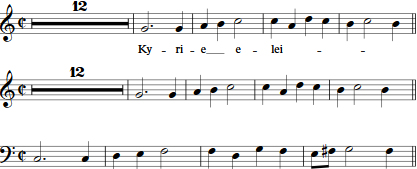
Gloria
 Sections
Sections
-
4. Gloria
Tempo: Allegro
Metre:
3
4
Key: C major
Extent: 112 bars

-
5. Laudamus
Tempo: Andante
Metre:
2
4
Key: C major
Extent: 99 bars

-
6. Gratias
Tempo: Allegro
Metre:
3
4
Key: C major
Extent: 78 bars
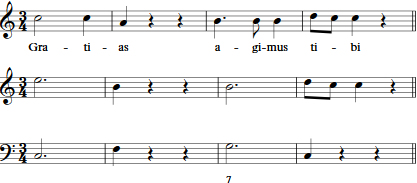
-
7. Domine Deus
Tempo: Andante
Metre:
𝄴
Key: C minor
Extent: 34 bars
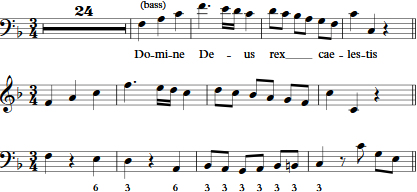
-
8. Domine Deus agnus Dei
Tempo: Adagio
Metre:
𝄴
Key: C minor
Extent: 34 bars

-
9. Quoniam
Tempo: Allegro moderato
Metre:
3
4
Key: C major
Extent: 118 bars
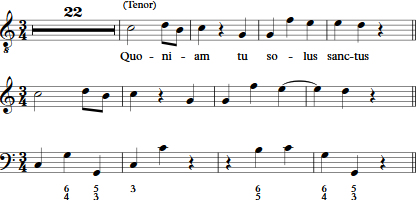
-
10. Cum sancto spiritu
Tempo: Adagio
Metre:
𝄵
Key: C major
Extent: 6 bars
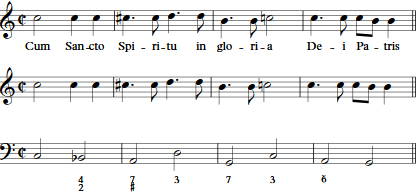
-
Amen
Tempo: Allegro
Extent: 81 bars

Credo
 Sections
Sections
-
11. Credo
Tempo: Allegro
Metre:
3
4
Key: C major
Extent: 94 bars
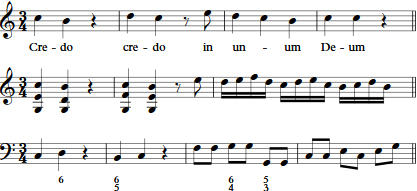
-
12. Et incarnatus
Tempo: Adagio
Metre:
𝄵
Key: C major
Extent: 100 bars
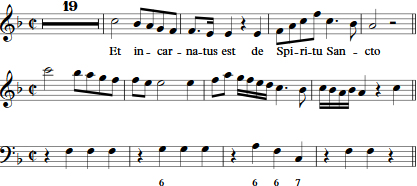
-
13. Et ressurexit
Tempo: Allegro
Metre:
3
4
Key: C major
Extent: 180 bars
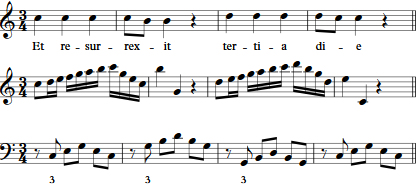
Sanctus
 Sections
Sections
Agnus Dei
 Sections
Sections
-
17. Agnus Dei
Tempo: Andante molto
Metre:
3
4
Key: C minor
Extent: 75 bars
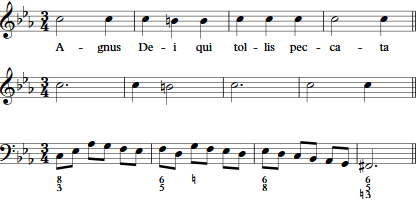
-
18. Dona nobis
Tempo: Andante
Metre:
3
4
Key: C major
Extent: 116 bars
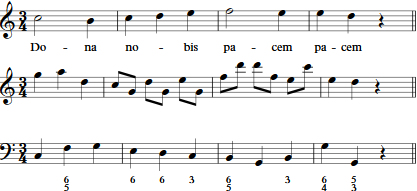
 Sources
Sources
Performance material, Moravian Museum, Brno
[Classification: notated music, print, copy, parts, fair copy, incomplete]
Title page: Front
page: Missa sollenis in C/a/Canto, Alto, Tenore, Basso./Violino Primo et
Secondo/Clarinetto Primo et Secondo./Clarino Primo et Secondo./Alto
Viola et Tympano/con/Organo/Auth. Wanhal/Tempier.
Vl1 missing.
CZ-Bm A 22843.
Performance material, Czech Museum of Music, Prague
[Classification: notated music, manuscript, copy, parts, fair copy]
Scribe: Jan Jakup Trautzl.
Front page: Missa
ex C / Solennis / ã / Canto, Alto, / Tenore, Basso / Violino Primo, /
Violino Secondo, / Oboe Primo, / Oboe Secondo, / Clarino Primo, /
Clarino Secondo, / Alto=Viola / con / Organo / Autore Sigl Giovanne
Wanhall // Pro / Choro Ossecensi / 1784
Tenore, last page: Wanig.
Basso, last page: Wanig.
Provenance: Cistercian monastery, Osek.
 Library index card
Library index card
CZ-Pnm XXXIII A 31.
Osek1754 deest..
OsekModern p. 63.
Copy, Augustinian monastery, St. Florian
Title page: Missa a 4 Voci, 2 Viol, 2 Ob., 2 Clarini, Timp., Organo, Violone.
Not seen. Information taken from Weinmann1987.
A-SF II 425.
Copy, Cistercian monastery, Wilhering
Title page: [cover]
Missa Ex C. | a | 4 Vocibus | 2 Violinis | 2 Obois. | 2 Clarinis. |
Tybano [!] | Viola et Violone. | Con | Organo. | Del Signore Giovani
Vannhal.
Not seen. Information taken from RISM.
 RISM
RISM
A-WIL Ms. 1104.
RISM 600077677.
Copy, Moravian Museum, Brno
Catalogue entry in Raigern1779: Sacrum
Solemme in C a 4 Voci 2 Violini Alto Viol. Oblig. 2 Clarini et Tympano
con Organo. Proc. P. Maurus Haberhauer [1]779. / and.[ante] [incipit]
Wanhal/E.IV.N.13.
Not seen. Information taken from Raigern1771. Originally made in Raigern.
CZ-Bm A 13095.
Raigern1771 304.
Copy, Moravian Museum, Brno
Not seen. Information taken from Weinmann1987.
CZ-Bm A 20464.
Copy, Moravian Monastery, Brno
Not seen. Information taken from Weinmann1987. Originally from the Augustinian monastery in Brno.
CZ-Bm A 20964.
Copy, Czech Museum of Music, Prague
Title page: Missa solemnis à C.A.T.B. 2 V. Va. 2 Ob. 2 Clar. Timp. Org. Del Sig Joanne Vannhal.
Not seen. Information taken from library index card.
 Library index card
Library index card
CZ-Pnm XVIII A 164.
Alleged copy, Gesellschaft der Musikfreunde
In the Weinmann catalogue there is supposed
to be a manuscript version of this mass, containing 13 voices, in the
Gesellschaft der Musikfreunde in Vienna. Weinmann did not include a
signature for this copy, however, and attempts to find it have failed.
No other sacred works by Wanhal exist in manuscript in the collection
(the printed masses C8 and G5 do). The existence of the manuscript
cannot be ruled out entirely, but it seems likely that this is based on a
misunderstanding: Weinmann died before he finished his catalogue, which
was subsequently made from his notes by colleagues, who may have
mistakenly put it there.
A-Wgm ?.
Copy, Schott Archives (Joseph Haydn)
Not seen, referred to in Hoboken1971 (p. 111)
D-MZsch ?.
Copy, Benedictine monastery, Lambach ('Monsching')
Not seen. Referred to in MacIntyre1984 (p.
45). The identity of 'Monsching' is unknown; however implausible it
seems most closely to match the name of the French composer
Pierre-Alexandre Monsigny (1729-1817), who among other things
collaborated with Gottfried van Swieten on an opera.
A-LA p. 26.
Modified version
Nokki 11b
Extent: 1370 bars
 Music
Music
1. Kyrie
Tempo: Andante
Metre:
3
4
Key: C major
Extent: 131 bars

Gloria
 Sections
Sections
Credo
 Sections
Sections
-
9. Credo
Tempo: Allegro
Metre:
3
4
Key: C major
Extent: 94 bars

-
10. Et incarnatus
Tempo: Adagio
Metre:
𝄵
Key: C major
Extent: 100 bars

-
11. Et ressurexit
Tempo: Allegro
Metre:
3
4
Key: C major
Extent: 99 bars
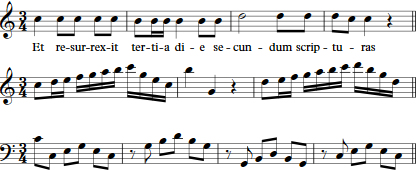
Sanctus
 Sections
Sections
Agnus Dei
 Sections
Sections
 Sources
Sources
Performance parts, Hohenlohe-Bartenstein Archive, Bartenstein
[Classification: notated music, manuscript, copy, parts]
Title page: Missa Solemnis in C
/ a 18 Parti / Canto, Alto, Tenore, Basso / Due Violini / Due Oboe /
Due Flauti / Due Corni, [to the right: '3 in Benedictus / et agnus
Dei.'] / Due Clarini in C. / Alto-Viola / Violoncello Violone / Organo /
Del Sigr Vanhal / ad Chorum Bartenstein
 RISM
RISM
 Scan
Scan
D-BAR Ba 120.
RISM 450001540.
Nokki 11c
Hoboken1971 XXII:C2
Arranger: Vincent Novello
Extent: 765 bars
 Music
Music
1. Kyrie
Tempo: Andante
Metre:
3
4
Key: C major
Extent: 128 bars

2. Gloria
Tempo: Allegro
Metre:
3
4
Key: C major
Extent: 99 bars
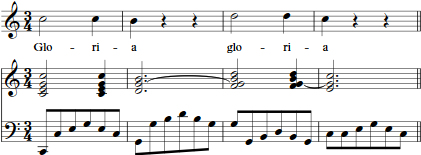
3. Credo
Tempo: Allegro
Metre:
3
4
Key: C major
Extent: 52 bars
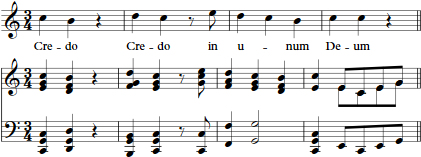
4. Et incarnatus est
Tempo: Larghetto
Metre:
3
4
Key: A minor
Extent: 36 bars

5. Et resurrexit
Tempo: Allegro
Metre:
3
4
Key: C major
Extent: 51 bars
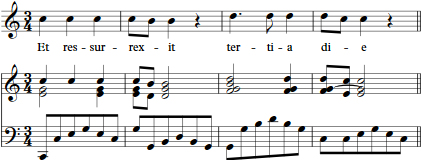
6. Sanctus
Tempo: Adagio
Metre:
𝄴
Key: C major
Extent: 5 bars
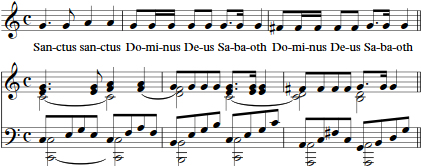
Pleni sunt coeli
Tempo: Allegro
Metre:
3
4
Key: C major
Extent: 21 bars
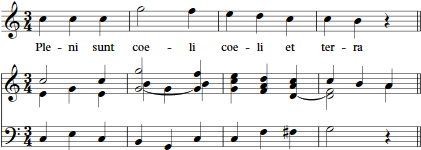
7. Benedictus
Tempo: Andante
Metre:
3
4
Key: F major
Extent: 158 bars
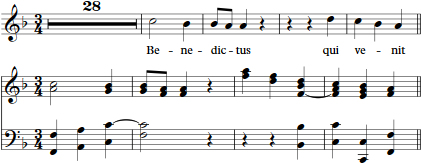
Osanna
Tempo: Allegro
Metre:
3
4
Key: C major
Extent: 12 bars
8. Agnus Dei
Tempo: Andante molto
Metre:
3
4
Key: C minor
Extent: 75 bars
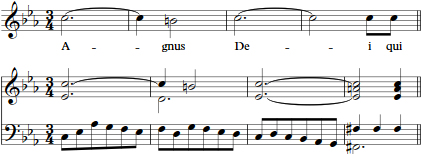
9. Dona nobis
Tempo: Andante
Metre:
3
4
Key: C major
Extent: 128 bars
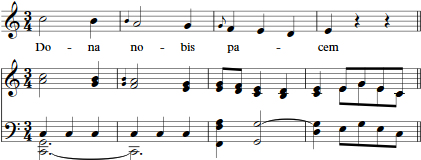
Re-texting of Kyrie.
 Sources
Sources
Published score, Novello (Joseph Haydn)
[Classification: notated music, print, parts, first edition, complete]
Arranger: Vincent Novello.
Vincent Novello, London 1870s?.
Referred to in Hoboken1971 (p. 111)
DK-Kk U10, 1951-52.70, U10.
GB-Dru SC+ 04234 v.2.
GB-Lbl Music Collections B.550.a.
US-Cp M2013.H4 H.XXII C2 N68 1800z.
US-NYcu 82.7 H324 M6.
(Thousand Oaks Public Library, San Antonio) deest.
(King Library, San Jose State University) M2013 .H4 H.XXII, C2, 1870x.
Holzmann arrangement for keyboard and SA voices
Composer: Joseph Alois Holzmann
Performer: Joseph Branböck
Extent: 155 bars
 Music
Music
1. Kyrie
Tempo: Allegretto
Metre:
3
4
Key: D major
Extent: 60 bars
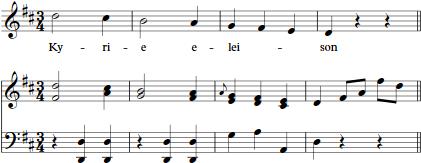
2. Gloria
Tempo: Allegro molto
Metre:
2
4
Key: D major
Extent: 33 bars
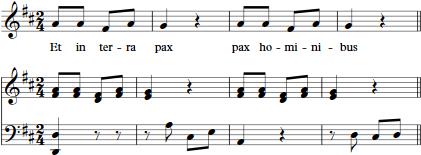
3. Credo
Tempo: Allegro
Metre:
3
4
Key: D major
Extent: 36 bars
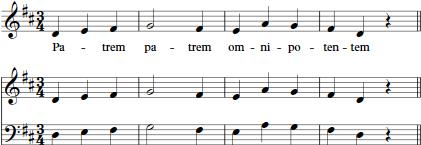
4. Sanctus
Tempo: Adagio
Metre:
𝄴
Key: D major
Extent: 6 bars
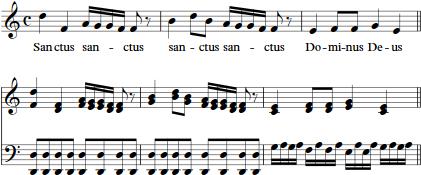
Pleni sunt coeli
Tempo: Allegro molto
Metre:
2
4
Key: D major
Extent: 20 bars

 Sources
Sources
Performance parts, Bavarian State Library, Munich (Joseph Alois Holzmann)
[Classification: notated music, manuscript, copy, parts, complete]
Scribes: Joseph Bramböck, Peter Huber.
Title page:
Thono ex D. / Missa VIII / Canto / et / Organo. // Del Sig: Giuseppe / Holzmann. // adme Joseph Branböck / org: in Niederndorf 1798.
Org., last page: abgeschrieben den 16|t|e|n September / 1798.
Provenance: Niederndorf
 Library catalogue entry
Library catalogue entry
 Digital manuscript copy
Digital manuscript copy
 RISM
RISM
D-Mbs Mus.ms. 7470.
RISM 450057474.
 Bibliography
Bibliography
Haberkamp, Gertrude and Martin Seelkopf:
Musikhandschriften katholischer Pfarreien in Franken, Bistum Würzburg. G. Henle: Munich 1990.
Hoboken, Antony van:
Thematisch bibliographisches Werkverzeichnis. B.basso (bass)
Schotts Sohne: Mainz 1971: vol. II.
MacIntyre, Bruce C.:
'Haydn's Doubtful and Spurious Masses: An Attributional Update', in: Haydn-Studien, vol.
V (Munich: G. Henle 1982).
Obermayr, Anton:
[Catalogus musicalium et instrumentarium ad chorum Lambascensem pertinentium] The Lambach thematic catalogue (1768). Pendragon: Styuvesant, NY 2000.
Osek u Duchcova. (CZ-Pnm; modern catalogue)
sYLLabVs seV CataLogVs perVtILIs non
ChoraLIa, VerVM fIgVraLIa pIa festIVI ChorI porferens artIfICIa, qVæ pro
feLICI offICIJ habItI fVaVIorIs Instar MUsICæ fILIaLI eX reVerentIa.... Osek 1753-1894. (CZ-Pnm)
 Scores
Scores
Haydn, Joseph [Misattributed]:
Haydns Masses. Novello, Ewer & Co.: London 1855: vol. 13. This is an edition of Nokki 11c.
Wanhal, Johann Baptist:
Missa Solennis in C major, W.XIX:C2. IMSLP: 2017. This is an edition of Nokki 11b.  IMSLP Edition
IMSLP Edition
File title:
Missa in C Nokki 11 [Weinmann XIX:C2]
File publication:
Editor: Halvor K Hosar
Last changed 2020-11-21 by
Halvor K Hosar
 Revision history
Revision history
| Date |
Responsible |
Description |
| 2020-11-21 |
Halvor K Hosar |
|
 Music
Music













